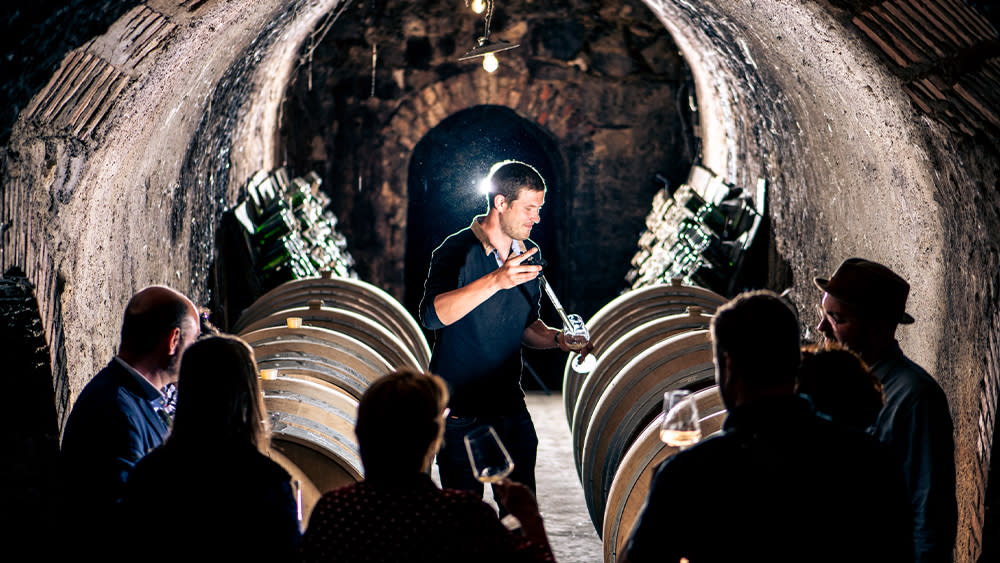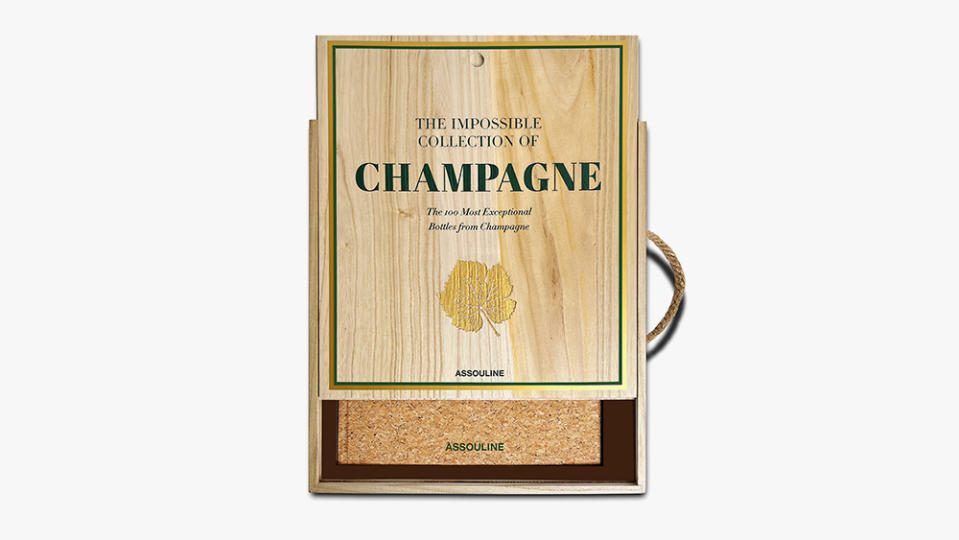This New Coffee Table Book Tells the True History of Champagne Through 100 Iconic Bottles

Everyone who drinks wine has heard the tale of how Champagne was first discovered by the Bendectine monk Pierre Pérignon (1638–1715), who was better known by his monastic title, Dom Pérignon. While winemaking monks are credited with many improvements in vineyard and cellar techniques in several regions throughout France, it seems that the legend of the blind monk who tasted refermented wine for the first time and then called out to his fellow priests, “Come quickly, I am tasting the stars,” is nothing more than a good story.
This bit of myth busting is one of the first things one will learn while perusing Enrico Bernardo’s The Impossible Collection of Champagne (which retails for $995), a lavishly illustrated and wood-crated book recently released by Assouline. More than just a coffee table tome, Bernardo’s personal recollections of savoring the 100 Champagnes profiled within is illustrated with the labels of the bottles themselves plus gorgeous photography and drawings.
More from Robb Report
The 11 Best Wines for Your Holiday Feast, From Napa Cab to Burgundy Grand Cru
The World Cup Banned Booze, but the Stadium's Most Exclusive Areas Are Still Slinging Drinks
Although the book is a love letter to Champagne, Bernardo, who earned the title Best Sommelier in the World in 2004, includes the incredibly unromantic but true Champagne origin story in the book’s introduction, informing readers, “When English merchants, who were then the region’s principal customers, received shipments from Champagne—a still wine at the time—they added sugar in the course of transferring it from barrel to bottle, as was the fashion then, and sometimes spices too. The wine would quite rapidly begin to re-ferment in bottle, developing the carbon dioxide gas that gives birth to Champagne’s highly appreciated effervescence.”
While the British may deserve credit for accidentally inventing sparkling Champagne, it is undoubtedly Dom Pérignon, who was then cellarmaster at the Benedictine abbey of Hautvilliers, who helped to perfect the process, along with his colleague Dom Thierry Ruinart. Champagnes named for both of these winemaking clergymen are among the most famous in the world today. Bernardo memorializes several vintages of Dom Pérignon, including 1928, 1966 and 1985 as well as Ruinart 1988. The first part of Bernardo’s volume highlights very old, ultra-rare Champagnes such as Bollinger 1830 Cuvée de Réserve Renaudin Brut and Möet & Chandon 1900 Grand Vintage Brut.
Bernardo told Robb Report that if he could drink one glass of Champagne that no longer exists, it would be the Bollinger 1830, explaining, “It is the oldest bottle of champagne I have tasted in my life and the first vintage produced by the house. It is therefore a witness to history and it installs in all simplicity the majesty of this Champagne that the world envies France for producing. It was an honor to be able to taste it and appreciate its full form.”
In addition to well-known houses such as those already mentioned or Krug, Veuve Clicquot, Salon or Charles Heidsieck, the author includes many less familiar producers such as Boizel, Alfred Gratien, Eric Rodez and Tarlant. Asked about the differences between a large commercial house and a smaller producer, the author pointed out, “A commercial Champagne seeks to reproduce the same taste every year, their house signature, so whomever is tasting the Champagne will recognize the style of the house, while a winemaker expresses the differences between terroirs, thus marking the unique identity of its cuvée. The great houses make the prestige of Champagne shine . . . The role of independent winemakers is essential in consolidating the notion of terroir, the personality of a vintage bottle, of grape variety or of a location, with all possible nuances.”
From first page to last, Bernardo’s homage to the finest that Champagne has to offer is a visual and literary delight. Fortunately for readers, the author doesn’t just look to the distant and possibly unobtainable past; many of the later vintages covered toward the end of the book are still in the market. Bernardo has an eye on the future as well. He told Robb Report that the best vintage Champagnes on the market currently are 2008 and 2012, but that readers should be on the lookout for 2019 when it is released in several years.
Best of Robb Report
Why a Heritage Turkey Is the Best Thanksgiving Bird—and How to Get One
The 10 Best Wines to Pair With Steak, From Cabernet to Malbec
Sign up for Robb Report's Newsletter. For the latest news, follow us on Facebook, Twitter, and Instagram.


